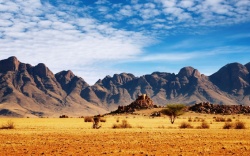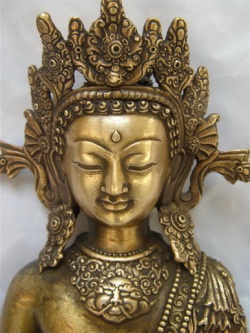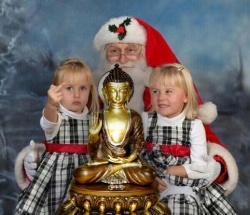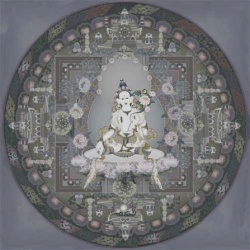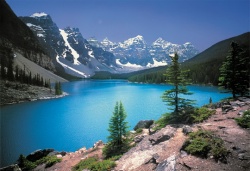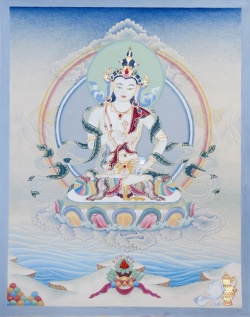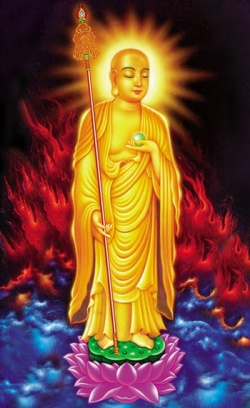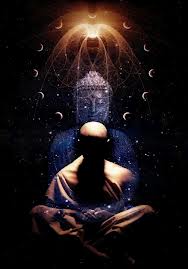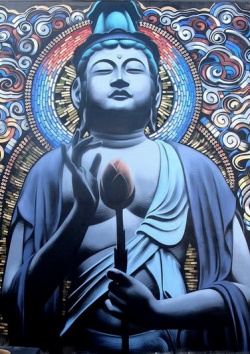The Inverted Tree Mysticism of Earliest Buddhism and Vedanta. Its Metaphysical Meaning and Importance
The expression brahma vrksa, "Brahma tree," in the Mahabharata (Aslvamedha Parva xivii.14), points backward to MU 4.4, where the One Asvattha is identified with Brahman; SAXI.2,where the Brahman stands up as a great green Tree; and finally to the question asked in RV x.31.7 and x.81.4, "What was the Wood, and what the Tree, of which they fashioned Heaven and Earth," with its answer in TB ii.8.9.6,
"The Wood was Brahman, Brahman the Tree, of which they fashioned Heaven and Earth: it is my deliberate word, ye knowledgeable men, that there stands Brahman, world supporting."(1) Bearing in mind the equivalence of Mitravarunau andapara and para Brahman, and the designation of Varuna in the Rg Veda and of Brahman in the Brahmanas and Upanishads as yaksa, it can readily be seen in what sense Brahman is thought of both as root and branch of one and the same Tree.
The Brahman being a single essence with two natures (dvaidhibhavah, MU 7.2.8),"in a likeness and not in any likeness (murtam camurtam ca), mortal and immortal, local and pervasive (sthitam, yat), existent and beyond (sat, tyat), solar (Ya esatapati) and intrasolar" (ya esa etasmin mandale purusah, BU 2.3.1-3, cf. MU 6.3,15,36, etc.),
Brahma tree is necessarily to be considered from the same point of view; in other words, either as rooted in the dark ground of the Godhead and as standing up and branching out in the manifested Cosmos, and therefore inverted, or as consisting of a continuous stem having two parts, of which one extends as the Axis of the Universe from Earth to Heaven, while the other branches above the roof of the world in Paradise.(2) In accordance with RV X.I2I.2 "His shadow is both of death and of immortality," we can identify these "parts" of the Tree with the Tree of Death and Tree of Life of other traditions.
A twofold division, cosmic and supracosmic, of the Axial Column is clearly enunciated in AV x.7.3, where the skambha (in which the Devas inhere "like branches of a tree about its trunk," the solar Tree in which the Brahman Yaksa moves on the face of the waters, ibid., 38) is fourfold, three of its members (anga,)corresponding to earth, air, and sky (the three worlds of the cosmos), while the fourth "stands beyond the sky" (tisthaty uttaram divah). This division is already explicit in RV x.9o.3 4, where the Person's "one foot is all beings,(3) and three feet immortality in heaven (amrtam divi); with three feet he is up above (urdhvah), one foot of him is that which is born repeatedly (abhavat punah)," and repeated in MU VII.II.8, where the Brahman "moves (carati) with one foot in the three (stations), and with three in the higher (uttare)," of which the "fourth" station, "beyond that of sleep" (suptat parah), is the "greatest" (mahattaram).(4)
This involves, of course, the usual trinitarian arrangement of the Brahman, which makes of the proceeding deity Three Persons (Agni, Indra Vayu, Aditya) and of the transcendent deity One Principle in whom the distinction of these Persons is lost.(5) Thought of, then, as Pillar or Tree, the Person, Brahman, Prajapati, stands in part within the cosmos and in what is a greater part also out beyond the sky. AV X.710 asks where in the Pillar are these parts, "the Existent and the Nonexistent" (asac ca yatra sac canta skambham, tam brumi).(6) The answer follows in verse 21"The (higher) (7) kindreds know the steadfast Nonexistent bough as the supernal; those below who worship this thy bough are aware of it as the Existent" (asacchakham prati'sthantim paramam iva jand viduh; uto san manyante'vare ye to sdkhdm upasate),(8) and verse 25, "The higher kindreds call that One limb of the Pillar the Nonexistent" (ekam tad angam skambhasyusad uhuh paro Janah);(9) verse 26 substitutes "Ancient" (puranam) for "Nonexistent" (asat).
We defer the question of whether the lower part of the Pillar must be thought of as inverted with respect to the higher, but call attention to the fact that the Pillar, in its lower and cosmicextension, may properly be called a "Tree of the knowledge of good and evil," for as MU VII.II.8 (cited above) continues, "The twofold nature (dvaitibhava) of the Great Spirit (mahatmanah, the Sun) is for the sake of experiencing both the true and the false (satydnrtopabhogarthah)," by which "true and false" are clearlydenoted the two worlds, respectively celestial and infrasolar, immortal and mortal, designated in SB 1.9.3.23 as superhuman (amanusa daivya) and human (manusa),true (satyam) and false (anrtam); cf. the distinction in CU VIII.1 of true desires (satyah kamah) and these same desires "falsified" (anrtapidhanah), the former to be found by going "there," the latter those that men pursue "here."
Indeed, it follows inevitably from the doctrine of "one essence and two natures" attributed to Varuna, Agni, or Brahman throughout the Vedic tradition that insofar as the Deity is represented by a Tree, this can only be thought of either as a single Tree to which the contrasted aspects of the Deity are as in RV i.164.20, differently related, or as two different Trees, respectively cosmic and supracosmic, manifested and unmanifested but indwelt throughout by the single Brahman Yaksa.
This duality is explicit in connection with the palasa (tree or leaf)(10) expressly identified with the Brahman in SB I.3.3.9 vi.6.3.7, and VII.I.I.5. In JUB1.20.3, we findthat just as heaven and earth are represented by the two wheels of the solar chariot, separated and connected by their common axle tree (aksa; the "separating breath," vyana of RV x.85.12 and SB VII1.2.21 ), so they are represented by " two palaces," pillared apart by their common stem or trunk (yatha kasthena pala'se visabdhe syatam,(11) a sena va cakrav, evam etena Cantariksena (12) imau lokau vis abdhau ; and this is quite in accordance with RV x.135.1, where Yama's suprasolarParadise is "in a fair palasa tree" (vrkse supalase , evidently the same as the asvattha of AV v.4.3. Yama's supalasa is the higher of the "two palasas" of the Jaiminiya Upanisad Brahmana. The memory of these two palasas, or twofold palasas, seems to be preserved in the name of the Dupalasa ceiya famous yaksa shrine referred to in the Uva saga Dasa 0 3.(13) The problem presents itself again in connection with the Soma as Tree of Life.
For of "the immortal nectar hid in heaven" (divi . . . amrtam nigulham, RV m.44.2324), "that which the Brahmans know as Soma, none soever drinks on earth" (RV x.85.3 4), but on the contrary, of various substitutes, notably the nyagrodha (pipal):in AB VII 3I, "The nyagrodha is metaphysically (paroksam) king Soma; metaphysically [transubstantially] the Temporal power (ksatriya) attains to the form of the Spiritual power (brahmano rupam upanigacchati) by means of the priest, the initiation, and the invitation"; similarly KB XII.5, where the Sacrificer (if himself a priest)partakes of Soma "mentally, visually, aurally," etc., and "thus by him yonder Soma, the king, the discerning, the moon, the food is eaten, that food yonder that the Devas eat." We have thus to do with a Soma up above, and another "Soma" here below; the former is. partaken of only transubstantially
The Avestan tradition also knows of two Haoma trees, a white and a yellow, heavenly and earthly; the relevant texts are collected in W. H. Ward, Seal Cylinders of Western Asia (Washington, D.C., I9I0) , pp. 232 a36. The Gokart or Gaokarena, the White Haoma risen from the midst of the sea Vouro kash,(14) where it sprang up on the first day, is the Tree of the solar Eagle (soma or simurgh, corresponding to the Indian syena, garuda, suparna) ; it is sometimes confused with and sometimes distinguished from the "Tree of All Seeds" which grows beside it (there is no hint of a inversion), of which the seeds, sent down with the rain, are the germs of all living things.
The notion of a "Tree of All Seeds"(15) corresponds to the Indian conception of the Tree or Pillar as a single form in which all other principles inhere(RV x.82.6; AV x.7.38, etc.). In the old Semitic tradition, likewise, vii., in Genesis 3, a distinction is made between two Trees, respectively of the "Knowledge of Good and Evil," and of "Life"; man, having eaten of the former, is driven out of the Garden of Eden, the gate of which is defended against him by Cherubim and a "flamingsword which turned every way, to keep the way of the Tree of Life."
Both of these Trees are "in the midst of the garden" (Gen. 2:9), which is as much as to say "at the navel of the earth." One is tempted to ask if these Trees are not in reality one, a Tree of Life for those who do not eat of its fruits and a tree of life and death for those who do; just as in RV 1.164.20, the Tree is one (samanam vrksam), and of the Eagles there is one that is all seeing, and another who "eats of the fruit"(pippalam atti). The words of verse 22, "upon its top, they say, the fig is sweet none getteth it who knoweth not the Father," imply (what is explicit elsewhere in connection with the rites of climbing)(16) that all the difference between life and death on the one hand and Eternal Life on the other can be expressed in terms of eating of the fruits of the lower branches, and of the fruit that is only for the Comprehensor who reaches the "top of the tree."(17)
The Zohar (Shelah Lecha) distinguishes the Trees as higher and lower: "Observe that there are two Trees,(18) one higher and one lower, in the one of which is life and in the other death, and he who confuses them brings death upon himself in this world and has no portion in the world to come." These Trees are nevertheless so closely related that a transmutation can be effected: "This verse (Prov.11:24) testifies that whoever gives to the poor induces the Tree of Life to add of itself to the Tree of Death, so that life and joy prevail on high, and so that that man, whenever in need has the Tree of Life to stand by him and the Tree of Death to shield him"(Zohar, Beha 'Alotheka) (19) The two Trees are also contrasted as follows:
"All over souls emanate from a high and mighty Tree . . . and all spirits from another and smaller Tree . . . when these unite, they shine with a celestial light . . . . For the feminine is in the image of the small Tree . . . the lower, feminine Tree, and had to receive life from another Tree . . . . when the Holy One grants the sinner grace and strength to accomplish his return to righteousness . . . the man himself (who as a sinner had been `dead' is truly and perfectly alive, being joined to the Tree of Life. And, being united with the Tree of Life, he is called `a man of repentance' for he is become a member of the Community of Israel"(20) Zohar, Mishpatim, III, 3o3 324) (21)
Before proceeding to a more detailed account of the Inverted Tree as described in the Indian texts (and elsewhere), a few words may be said on the two names bywhich the Tree is commonly referred to: asvattha (ficus religiosa, pippala) and nyagrodha (ficus indica, vata, banyan). (22) The word Asvattha is understood to mean the "Station of the Horse" (asvastha), the Horse being Agni and/or the Sun; that this is the proper interpretation is placed almost beyond doubt by the repeated expression "as unto the standing horse" (aslvayeva tisthante) , with reference to offerings made to Agni kindled at the navel of the earth (23) e.g., in TS 4.1.10,“bearing for him as fodder to a stalled horse . . . kindled on earth's navel Agni we invoke" (asvaye'va tisthante ghzimam asmai . . . nabha prthlvyii samidhdnam agnim. . . havamahe), and similarly AV 111.15.8, VS, XI 75, SB v 6.6 3.8 and from, the fact that asvattha is a designation of the solar Visnu in the Mahabharata (E. w.Hopkins, Epic Mythology, Strasbourg, 1915, pp. 6 and 208 20 .
Nyagrodha means "downward growing" not merely insofar as this is actually represented by thegrowth of aerial roots but because the Tree itself is thought of as inverted, as is clear from AB VII 30, where the bowls which the Devas “tilted over (nyubjan); they became the nyagrodha trees. Even today in Kuruksetra men call these (trees) `nyubjas.' They were the first born of nyagrodhas ; from them are the others born. Inthat they grew downwards, and accordingly the nyagrodha `grows downwards,' and its name is `nyagrodha' being nyagroha [`growing downwards'], the Devas call it nyagrodha parabolically." This explanation recurs in SB XIII.2.7.3.
In every country the World tree is of a species proper to the country in which the tradition has been localized for example, in Scandinavia an oak, and for Dante anapple. In Siberia the Tree is a birch: this birch is set up in hypaethral shrines comparable to the Buddhist bodhi gharas, it is called significantly the "Door god," and there are climbing rites analogous to those of the Brahmanas and Samhitas.(24)
The idea of an erect and of an inverted Tree is met with over a range of time and space extending from Plato to Dante and Siberia to India and Melanesia. Most likely the proto Vedic tradition already knew of both. In this case it might be supposed that in India the asvattha was taken to be the type of the erect, and the nyagrodha, because of its downward striking aerial roots, as the type of the inverted Tree.
The aksaya vata at Bodhgaya is, however, not an asvattha, but a nyagrodha; the Pali texts refer to the Bodhi tree now as asattha, and now as nigrodha; the Tree in Buddhist art and existing shrines is an asvattha; and the Inverted Tree of KU 6.1 and similar texts is specifically spoken of as the "One Asvattha."
In other words, the Trees are not clearly distinguished in practice; and if the distinction of meaning so admirably made in the two names asvattha and nyagrodha continued to be felt, it must have been rather within an esoteric doctrine than publicly.
That the doctrine of the Inverted Tree has always been an esoteric doctrine is far from unlikely; this is, indeed, suggested by AB VII.30, where the meaning of the ritual is evidently a "mystery," and also by what has been said of Soma above, cf. RV 1.139.2, where it is a matter of "seeing the golden," i.e., the immortal, "with these our eyes, the eyes of Soma," which "eyes" are those of "contemplation and intellect" (dhi and manas)and, in AB 11.32, "silent praise."
We turn now to a consideration of the texts in which the Inverted Tree, of whatever species, is described as such. RV1.24 7 is explicit: "In the unground (air) King Varuna, Pure power, upholds the Tree's crest (vanasya stupam); its ground is up above; [its branches] are below; (25) may their banners [or oriflammes] be planted deep in us" (abudhne rdjd varuno vanasyordhvam stupam dadate pfitadaksah; nic.indh sthur upari budhna esam asrne antar nihitala ketavah syuh).
For the wordstupa, cf. RVV11.2.1, where we hive, addressed to Agni, "touch heaven's summit with thy crests (stupaih), overspread it with the rays of the sun," and the epithet shiranya stupa and arusa stupa applied to Agni in x.149.5 and 111.29 3. In VS 2.2, visno stupah is certainly "Visnu's crest" (Sikha); see TS I.I.II.I and SB I.3.3.5 The Tree, then, hangs from overhead downwards. At the same time, a distinction of crown from trunk is not essential: the Tree is a fiery pillar as seen from below, a solar pillar as from above, and a pneumatic pillar throughout; it is a Tree of Light,(26) most like that of the Zohar to be cited presently.
Sayana rightly understands that the Tree is a "Burning Bush"(27) the ketavah are "rays" (rasmayah.) and "breaths of life" (pranah), the stupa an "aggregate of fiery energy" (tejasah samgham). That the rays tend downwards is in accordance with the often emphasized fact that the rays of the Sun strike downwards; cf. SBVII.4.1.18, where the gold plate representing the solar Orb is laid down "so as to look hitherwards" (arvancam) .
In other words, the rays, thought of as the branches of a Tree of which the root is up above, spread downwards; while if we think of the flames as the branches of a Tree rising from a root below (Agni as Vanaspati),then all these flames rise upward (RV 111.8.11, "Arise, Vanaspati, a hundred branched," vanaspate satavalso viroha), their axial flame reaching and lighting up the Sun himself.
In the same way, if we consider the "breaths," which are the "rays" in their pneumatic aspect: the Sun, or solar Fire is the "Breath" (prana), and it is because he "kisses" (breathes upon) all his children that each can say "I am,"(28) being thus inspired, while Agni is the "breathing up" (udana) or aspiration, and these two are separated and connected by the "separating breath" (vyana); these three breathings together make up the whole of what is called "spiration" (prana),the "whole Spirit" (sarva atma) of Prajapati (SB, VII.I.2.2I and VII.3.2.I2 I3) .
The World tree thus inevitably burns or lightens at the same time upwards or downwards according to our point of view, which may be either as from below or as from above. The same can be expressed in another way in connection with the rites of climbing: where, just as "the Devas then traversed these worlds by means of the `Universal lights' (visvajyotibhih, i.e., by mews of Agni, Vayu and Aditya,(29) as`stepping stones' or `rungs,' samyanyah),(30) both from hence upwards and from above downwards (cordhavanam carvacah), even so does the Sacrificer now"(SB, VIII.7.I.23; cf. TS 5.3.10); for example,
"Even as one would keep ascending a tree by steps (akramanair ukramanah; cf. TS m.6.6.4.1), even so . . . he keeps ascending these worlds" (iman lokan rohan eti, JUB I.3.2); "he mounts the difficult mounting (durohanam rohati)," reaching Heaven, and again "descends as oneholding onto a branch" (pratyavarohati yatha sakham dharamanayah) until he 'is reestablished on earth (AB IV.2I 31a ) (31) or, to express this in terms of AV x.7.21(cited above), returns from Nonexistence to Existence, ox using those of SB 1.9.3.23, from the superhuman and true to the human and false plane of being.
The important text AV x.7.8 (cf. also RV x.8,.6) describes the procession of the (Brahman ) Yaksa: "A great Yaksa at the center of the world, proceeding in a glowing (i.e., as the Span) on the back (i.e., surface) of the ocean, therein are set the Deities, as it were branches round about the Tree's trunk" (vrksasya skandhahparl'ta iva sakhah); nothing in the text itself is explicit as to erection or inversion; only if we rely on the equation of "Yaksa" with "Varuna" in RV 7.88.6 and x.88.23and correlate the text with RV 1.24.7 can it be assumed teat the 'free is inverted. AV 2.7.3,
"From the sky is the root stretched down (di'vo mulam avatatam), on the earth stretched out, with this, the thousand jointed, do thou protect us about onall sides," concerning an unnamed "plant," is apparently contradicted by AV xix.32.3, where the thousand jointed darbha, invoked for long life, and evidentlyassimilated to the Axis of the Universe, since in 4 and 7 it is said to have pierced the three skies and three earths (three worlds) and is called "god born" (deva lidta)and "sky prop" (di'vi skambha), is described as planted on earth with its tuft in heaven (divi to tulam osudhe prthivyam asi nisthitah).
We find ourselves, however, on sure ground in KU vi.i, MU v1 4, and BG xv.1 3, where the Tree is described as inverted and called an Asvattha. In KU: "With roots above and branches down (urdhva mulorvaksakah) is this everlasting Asvattha: that is the Bright Sun (Sukram), (32) that is Brahman, that is called the Immortal,there in all worlds are set, beyond it none soever goeth, This indeed is That." "Beyond it nonesoever goes" corresponds to KU III.II, "beyond the Person there is naught, that is the end, the final goad (kastha)," and AV x.7.31, "beyond it [the skambha) there is no more any being." In MU 6.4,
"The three quarter Brahman [i.e., Tree as extended within the cosmos from earth to sky] has his roots above. Its branches are the ether, air, fire, water,earth, etc. This Brahman has the name the ‘One Asvattha.’ Pertaining to it is the fiery energy (tejas) that is yonder Sun, and the fiery energy of the imperishable logos(OM); wherefore one should worship it (upasita; cf. AV X.7.2I, avare ye to sakham upasate) with this same `OM' incessantly; it is his `One Awakener' (eko'syasambodhayitr)." MU VIII I , on the other hand, describes the Burning Bush, Agni' as Vanaspati, as it branches forth in space:
"This, indeed, is the intrinsic form ofspace (svarupam nabhasah) in the hollow of the inner being (khe antarbhutasya), that which is the supreme fiery energy (tejas) is threefold in Agni, in the Sun, and inthe Breath . . . that the imperishable logos (OM), whereby, indeed, it awakens, ascends, aspires, a perpetual support for the contemplation of Brahman (ajasrambrahma dhiyalambam).
In the draught, that is stationed in the heat, that casts forth light; branching forth and rising up, as of smoke when there is a draught, itmoveth on, stem upon stem (skandhat skandham)." In these two passages the contrast of the Inverted Tree as which the Brahman descends into the cosmos anderected Tree as which he ascends from it is clearly drawn; both of these aspects of the one and only Tree being one and the same Logos, in the one case asproceeding from the Silence and Nonbeing, and in the other as returning to it.
BG xv.1 3 describes the Tree with equal fervor, but finally as one to be cut off at the root: "With root above and branches downward, the Asvattha is proclaimed unwasting : its leaves are the meters, he who knoweth it a knower of the Vedas.(33) Downwards and upwards both its branches are outspread, the outgrowths of the qualities; its shoots the objects of the senses, and its downward stretching roots the bonds of action in the world of men.
Nor here can be grasped its form, norcan its end or its beginning or its ultimate support: it is [only] when this firmly rooted Asvattha has been felled by the axe of nonattachment that the step beyond itcan be taken, whereby going there is no return."
Here the Tree is plainly described as rooted both above and below, and as branching both upwards anddownwards. We have already seen that the Axis of the Universe is, as it were, a ladder on which there is a perpetual going up and down. To have felled the Tree is tohave reached its top, and taken wing; to have become the Light itself which shines, and not merely one of its reflections.
In the Mahabharata (Asvamedha Parva 47.12 15) (34) we have "sprung from the Unmanifested (avyakta = asat of AV x.7.21 ), arising from it as only support, itstrunk is buddhi, its inward cavities, the channels of the senses, the great elements its branches, the objects of the senses its leaves, its fair flowers good and evil(dharmadharmav), pleasure and pain the consequent fruits.
This eternal Brahma tree (brahma vrksa) is the source of life (a’jivyah) for all beings. This is the Brahmawood, and of this Brahma tree That (Brahman) is. (35) Having cut asunder and broken the Tree with the weapon of Gnosis (jnanena), and thenceforth takingpleasure in the Spirit, none returneth thence again."
The very fine description of the Inverted Tree as a Tree of Light in the Zohar (Beha Alotheka, with reference to Psalms 19:6) accords with texts already cited,especially RVI.24.7 as interpreted by Sankara: we find, "Now the Tree of Life extends from above downward, and it is the Sun which illumines all. Its radiancecommences at the top and extends through the whole trunk in a straight line. It is composed of two sides, one to the north, one to the south, one to the right, andone to tie left. When the trunk shines, first the right arm of the Tree is illuminated and from its intensity the left side catches the light.
The `chamber' from which hegoes forth is the starting point of light, referred also in the next verse, `from the end of the heaven,' which is, indeed, the starting point of all. From that point he goesforth veritably as a bridegroom to meet his bride, the beloved of his soul, whom he receives with outstretched arm. The Sun proceeds and makes his way towardsthe west; when the west is approached, the north side bestirs itself to meet it, and joins it. Then `he rejoices as a strong man to run his course' so as to shed his lightupon the Moon.(36) Now the words `When thou lightest the lamps' contain an allusion to the celestial lamps, all of which are lit up together from the radiance of theSun," i.e., as the Light of lights.
In the Zohar (Bemidbar), the Tree of Life and Tree of Death are distinguished: "For as soon as the night falls the Tree of Death dominates the world and the Tree ofLife ascends(37) to the height of heights. And since the Tree of Death has sole rule of the world (cf. TS V.2 3 1; SB xi.3.37, and x.5.1, 4), all people in it have foretasteof death . . . when dawn breaks, then the Tree of Death departs and people come to life again by reason of the Tree of Life. This happens in accordance with what iswritten, `to see if there were any man of understanding that did seek after God.' " It is clear from the last sentence that Day and Night are to be taken as symbols, aswell as literally: the Tree of Life pertains to those who are verily awake, and that of Death to those who are still unawakened; cf. BG 11.61.
We must next consider the two Inverted Trees described in Dante's Purgatory, Cantos xxm xxv. These are met with near to the summit of the "mountain" and immediately below the plain of the Earthly Paradise, which is protected by a walk of flames (by which we understand the "flaming sword which turned every way, to keep the way of the Tree of Life" of Gen. 3:24, rather than the Keeper of the Sundoor of JUB 1.3, etc.) from which flames both Trees, met with in succession, seem to hang, and are represented in Botticelli's illustrations as thus dependent. If we arc to understand these Trees at all, we must take careful note of all that is said of them. The first "has a fruit sweet and pleasant to smell." A spring falls from above and moistens its leaves.(38)
It seems to Dante that the inversion of the Tree is "sothat none may go up" (cred'io perche Persona su non vada). The voice of the Virgin Mary "from within the foliage cried: 'Of this Tree shall ye have lack' " (Canto xxii).The emaciated shade of Forest adds: "From the eternal counsel virtue descends into the water, and into the Tree left behind (cade virtu nellacqua e nella piantarimasa rests), whereby I thus waste away. All this people, who weeping sing, sanctify themselves again in hunger and thirst, for having followed appetite to excess.The scent which issues from the fruit, and from the spray that is diffused over the green, kindles within us a desire to eat and drink.
And not once only, while circlingthis road, is our pain renewed: I do say `pain,' but should say 'solace,' for chat desire leads its to the Tree which led glad Christ to say: 'Eli; when as he freed its withhis blood" (Canto xxiii). We infer from the wording that this is a reflected and inverted image of the Tree of Life, for which the souls in the (cosmic) Purgatory hunger and thirst, but of which they can neither partake nor can they climb it.
Not much farther on, or higher, "the laden and green boughs of another Tree appeared to me . . . . I saw people beneath it lifting tip their hands, and crying outsomething towards the foliage, like spoilt and greedy children who beg, and he of whom they beg, answers not, but to make their longing full been, holds what theydesire on high, and hides it not. Then they departed as though undeceived; and now we Came to the great Tree which mucks so many prayers and tears.
'Passonward without drawing nigh to it; higher up (39) is a Tree which was eaten of by Eve, and this plant was raised from it.' Thus amid the branches some one spake"(Canto xxiv). The voice then cites examples of gluttony; it is evident that this inverted image of the Tree of the Knowledge of Good and Evil serves for thedisillusionment of those in whom desire is not yet overcame.
Dante is now about to emerge from the steep side (40) of the Mountain onto the plain of the Earthly Paradise at its summit. It must be realized that the "world" fromwhich Dante has climbed thus far, and to which he will return (Purgatorio 2.91 92) lies far below at the foot of the mountain, and that the Earthly Paradise has sincethe Fall been withdrawn to the summit of the fountain; Dante speaks of it as "one of the peaks of Parnassus" (Paradiso 1.16).
It is no longer on a level with. theinhabited world, neither is it a part of the purgatorial slope; its position is virtually supracosmic, it represents the "summit of contingent being" (bhavagra). The wayto it leads through flames which are, as it were, a "walk" (muro, Purgatorio 27.35) and through the rock (per entro il sasso, 27.64), which "entro" must have beensuch a cleft or tunnel and strait gate as Dante has previously called a "needle's eye" (cruna, x.16).
Virgil's guidance and leadership are of no further avail: "Son," he says, "the temporal fire and the eternal past thou seen, and art come to a plane where I, of myself, can discern no further. Here have I brought thee with wit and with art; now take thy pleasure for guide;(41) forth art thou from the steep ways, forth art from the narrow .... No more expect my word, nor my sign (Purgatorio 27. 127-139). Virgil, being still of human nature, can go no further; henceforth Dante's guide isBeatrice, "risen from flesh to spirit" (XXX.127) and, as Sophia rather than as the individual for whom he longed on earth, a being no longer "human." And were it notthat Dante himself divests himself of his humanity, he could have gone no further:
"gazing on her, such (as she was) I became within . . . . To pass beyond humanitymay not be told in words" (Paradiso 1.67 71) .(42) Even before this change has taken place, he has drunk of the Fountain of Life, Eunoe (fontana salda a certa,Purgatorio 28.124), and has been "born again, even as new trees renewed with new foliage, pure and ready to mount to the stars" (XXIII.142 145). From the point of view of conduct (prudence), the situation is summarized by Hermann Oelsner in The Purgatorio of Dante Alighliere (London, 1933), as follows:"The keynote of the Purgatory is primarily ethical ....
But the Church, as a regimen, is not to be confused with Revelation (Beatrice) herself.(43) The proper office ofthe Church, as a regimen, ends when the proper office of Beatrice begins": and accordingly, whatever sin Dante may have committed, "he will remember again, butas an external thing that does not now belong to his own personality.(44) The effort henceforth is no longer moral, but intellectual and spiritual.
It will be seen that the Great Transit ion (samparaya, KU 1.29, etc.), which for the Indian tradition depends upon a qualification to pass through the midst of the Sun(JUB 1.3 ff., III.I3 I4; isd Up. I5 I6, etc.) takes place for Dante in terms of the reentry to the Earthly Paradise, where at the end of the spiral ascent he sees erect that Tree of which Eve ate, thereby (as we seem to understand) reverting it; he stands now for the first time at the Navel of the Earth. (within the Bodhi mandala), from which point (45) the trunk of the arborescent Axis of the Universe,(46) of which the summit is "il punto dello stelo al cui la prima rota va dintorno" (Paradiso XIII.I2 I3),patterns an ascent no longer spiral but direct.
In other words, for Dante the critical passage from the human to the angelic level of reference separates the kamaloka which he has left from the rupaloka into which he enters at the summit of contingent being (bhavagra), rather than the rupaloka from the arupaloka in which he will not enter until the four lowest of the planetary heavens (of which the fourth is that of the Sun) have been past.
The gist of the whole matter for us is that the Trees,which seem to be different aspects of the only Tree, are inverted only below that point at which the rectification and regeneration of man takes place. Plato has also said, "Man is a heavenly plant; and what this means is that man is like an inverted tree, of which the roots tend heavenward and branches downwards to earth."(47) Furthermore, the symbol of the inverted tree is widely distributed in "folklore."
An Icelandic riddle asks, "Hast heard, O Heidrik, where thattree grows, of which the crown is on the earth, and of which the roots arises in heaven?" A Finnish lay speaks of an oak that grows in the floods, "upward its roots,downward its. crown." The Lapps sacrificed every year an ox to the god of vegetation, represented by an uprooted tree so placed on the altar that its crown wasdownward and roots upward. It is quite possible that the symbol of the Inverted Tree may have a distribution and antiquity as great as that of the Upright Tree. Whathas been cited already will suffice for present purposes. We shall attempt in conclusion to deduce from the scattered fragments of what must have been aconsistent doctrine, its ultimate significance.
Now just as the Atman, Brahman, is the Yaksa in the Tree of Life, which is the manifested aspect of the supracosmic Person, so also is Everyman an Atmanvat Yaksa (AV x.8.43), and, as it were, a tree (Job 18:16) "As is a tree, just such as is the Lord of Trees, so indeed is man" (BU III.9.8); and thus, as for Plato, "by nature a heavenly plant" (Timaeus).
He comes into being in the world because of the descent of a solar "ray" or "breath," which is the sowing of a seed in the field; and when he dies, the dust returns to the earth as it was, and the ray, on which his life depended, ascends to its source. We are not for the moment concerned with the ensuing judgment at the Sundoor which, if he is not qualified for admission, will permit the continued operation of those mediate causes by which the nature of a given birth is determined, and if he is qualified for admission will mean a final release from all individual causal order.
What we are concerned with is that the coming into being of the man presupposes a descent, and that the return to the source of being is an ascent; in this sense, the man, qua tree, is inverted at birth and erected at death. And this holds good as much for the Universal Man as for the microcosmic man, insofar as these are thought of as entering into and again departing from the cosmos, and hence as much to the "Person in the Sun" as to the "Person in the right eye" of the man, when both are thought of as the immanent principles of the vehicles on which they take their stand.
For when the transcendental Person, who is one eternally as he is yonder, enters into the world, he divides himself (atmanam vibhajya, MU VI.26, etc.), becoming many in his children in whom the spirit takes birth. This taking on of a passable mortal nature and "eating of the Tree ofthe Knowledge of food and Evil" (RV 1164; ; MU II.6d, etc.) is a descent, a dying, and a "fall," and even though we think of the Eternal Avatar's descent (avatarana,"coming down" or "inverse crossing") as a willing sacrifice undertaken for the sake of Every man's crossing over and ascent, the Solar Hero cannot evade theinevitable death of all those "who come eating and drinking," and must ascend again to the Father, entering thus into himself, who is himself the Way and the Sundoor through which he passes; stooping to conquer, still he stoops.
The descent of the Spirit is headlong; witness, for example, the descending Dove(equivalent of the Indian Hamsa) in the Christian iconography of the Baptism. Therefore we find in BU v.3 4 that "The head of the Person there in that solar orb is Earth. (bhur)....
His arms are Space (bhuvar) .... His feet the Heavenly light world (sear) "; in the same way for his microcosmic counterpart, "the head of the Personwho is here in the right eye is Earth,(48) etc. This is in complementary contrast to the normal formulation, typically in MU 6.6, where Prajapati's cosmic body.(pra'jpateh sthavista tanur yd lokavati) is erect, "its head is the Heavenly light world," etc.(49) He descends, in other. words, as Light, and ascends as Fire; and theseare the pneumatic countercurrents that pass ap and down the Axis Mundi. Again in other words, this means that as undivided (macrocosmically, he is erect; asmany (microcosmically), inverted.
It is, accordingly, the express intention of the sacrificial ritual that the Sacrificer should not only imitate the First Sacrifice but at one and the same time reintegrate and erect (in both senses of the word, to build up and set upright) the immanent and as it were divided and inverted Agni Prajapati, and himself. For Prajapati,"having emanated his children,(50) and won the race,(51) was unstrung (vyasransata) (52) and fell down (apadyata)."
The Devas, performing the First Sacrifice,reintegrated and erected him; and so now the Sacrificer, "reintegrating Father Prajapati so as to be all whole, erects him" (sarvam krtsnam samskrtyordhvamucchrayati, SBVII.I.2.1 and 11, with many analogous passages).
To this can also be applied the last words of BU v.5.4; cited above: "He who realizes this, smites offevil, leaves it behind." Realization will mean to have understood that this is a topsy turvy world; (53) that the Person in the right eye, man as he is in himself (aham,BU v.5.4), is an inverted or refracted principle, seen as if in a mirror, whether of water or the retina (CU VIII 7 4; BU v.5.4.);(54) it is for him to rectify himself, in such amanner as to be able to ascend these worlds (JUB 1.3), which cannot be done so long as the Tree is inverted.(55)
A remarkable illustration and confirmation of these conclusions can be cited in the Acts of Peter 37 39, where Peter beseeches his executioners, "Crucify me thus,with the head downwards, and not otherwise .... For the first man, whose race I bear in mine appearance, fell head downwards . . . . He, then, being pulled down . . .established this whole disposition of all things, being hanged up an image of the creation wherein he made the things of the right hand into left hand and the lefthand into right hand, and changed about all the marks of their nature, so that he thought those things that were not fair to be fair, and those that were in truth evil, tobe good. Concerning which the Lord saith in a mystery:
Unless ye make the things of the right hand as those of the left, and those of the left as those of the right,and those that are above as those below, and those that are behind as those that are before, ye shall not have knowledge of the kingdom.(56) This thought,therefore, have I declared unto you; and the figure wherein ye see me now hanging is the representation of that man that first carne unto birth. Ye therefore, mybeloved, and ye that hear me and shall hear, ought to cease from your former error and return back again.(57)
We have attempted to bring together some of the disjecta membra of an evidently consistent and intelligible symbolism, and are now perhaps in a better positionto understand why it is that the Tree of Life, extending from earth to heaven or heaven to earth and filling with its branches all the interspace, can be thought of bothas the "one Awakener" (eka sambodhayitr) and "everlasting basis of the contemplation of Brahman" (al'as ram brahma dhlyalambam) being, indeed, the Brahman(eko'svattha namaitad brahma,
MU iv.6 and 7.2 and the "uttermost full awakening" (anuttara samyak sambodhi, in Sukhavati Vyuha 32), but can also and with perfect consistency be called a tree that must be felled at the root "when this Asvattha, so nobly rooted, has been cut down with the axe of nonattachment, then is thatStation (padam) to be reached, whither having gone they return no more," BG xv.3 4.
"That is," as Sankara comments, "uprooting the Tree of the world vortextogether with its seed, he is to seek out and to know that way of the stride of Visnu, taking refuge with that Primordial Person from whom the Tree sprang up, asphantasmagoria oria from a juggler.(58) Sankara's explanation of the Inverted Tree of KU 6.1 and BG xv.1 3 may be summarized as follows: This is the "Tree of the World vortex" (samsara vrksa), compact of all desires and activities its downward branches are the worlds in which all creatures have their several beings.
It isrooted in the pure Light of the Spirit, in Brahman, immortal and immutable; as a Tree, resounding with the cries of all those, whether gods or men or animals orghosts, whose nests are in its branches, it is a growth without beginning or end in time, but of an ever changing aspect. The Tree has all to do with actions, whether ordinate or inordinate (karma dharma dharma laksanam), and their rewards (phalani), the "fruits of the tree." In this respect it is like the Vedas, which are anothermanifestation of the Brahmin: "He who knows the Tree of the World vortex and its Root as they are described in the cited texts is a Knower of the Vedas (vedavit);there is nothing more than this Trey of the World vortex and its Root that remains over to be known; whoever knows it, is omniscient.(59)
The felling of the Tree, or taking flight from its summit, involves, in other words, the usual substitution of the via remotionis for the via affirmativa; the greattransition involves a passing over from the Taught (saiksa) to the Untaught Way (asaiksa marga), the Spoken to the Unspoken Word. The Brahma tree (brahmavrksa), the Brahman in a likeness, as samsara vrksa, is an indispensable means to the knowledge of Brahman, but of no more use than any other means once the end of the road has been reached; it is a Tree to be used and also to be felled, because who ever clings to any means as if they were the end can never hope to reachthe end.(60)
The way of affirmation and denial applies then to the cosmic theophany, just as it applies to scripture. The Tree, as we have seen, is a manifestation ofAgni, Vayu, and Aditya; and "These are the preeminent forms (61) of the immortal, un embodied Brahman…These one should contemplate and praise, but then deny(ta abhidhyayed arcayen nihnuyac catas). For with these, indeed, one moves higher and higher in the worlds, and then when the whole comes to its end, reachesthe Unity of the Person, yea the Person" (ekatvam eti purusasya, MU 4.6) .
The conclusions thus reached are confirmed by the very significant text of AB II.I 2. Here the Devas, by means of the sacrifice, have ascended to heaven; and lestmen and prophets (rsayah) should follow after them, they "posted" (barred) the way by means of the sacrificial "post" (yupa) set point downwards (avicinagram).(62)Men and prophets, reaching the sacrificial site, realized what had been done.
They dug out the post and "dug it in again upright" (urddhva nyamanvan), using thewords, "Rise erect, O Lord of the Forest" (srayasva vanaspate, RV 1.36.13), "Aloft to our aid do thou stand like Savitr the God" (the Sun), and "Erect us" (63) for motion (carathaya), for life." Then they discerned the world of heaven. "In that the post is fixed upright (it avails) to the foreknowledge of the sacrifice and for thevision of the world of heaven"(64) (svargasya lokasy anukhyatai; cf. TS V.2.8.1, 6.3.4.8, etc.: svayamatrnna bhavati pranandm utsrstyai atho svargasyalokasyanukhyatyai).
Being set up on the surface of... the earth (varsma prthvyai), "banning mindlessness far from us (are asmad amatim badhamana iti), namelyprivation, evil (asanaya vai papmanam), "The Post is the Bolt (vajro vai yupah) , it stands erect as a weapon against him whom we hate (dvisato badha udyatishati) .(65) There are three kinds of wood, of which the post can be made' khadira, bilva, and palasa.
The latter is "the fiery energy and Brahma glory of the Lords of theForest" (tejo vai brahma varcasam vanaspatinam and "the birth place of all Lords of the Forest" (sarvesam vanas patinam yonih). In TS I1. the Lord of the Forest(elsewhere the common epithet of Agni) is identified with the Breath (prano vai vanaspatih) . It is perfectly clear from all this that 1the sacrificial "tree," yupa isthought of as inverted and unclimbable until it is erected by the setting upright of the symbolic post of the rite: wherewith erected the Sacrificer is himself erectedand regenerated.
Source
aryan-buddhism.blogspot.com.au [[Category:]Buddhist Philosophy)
